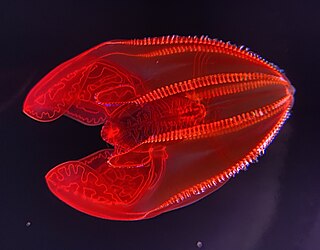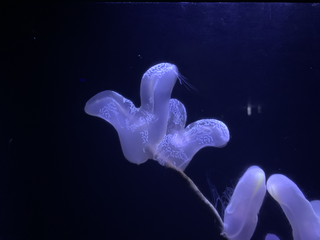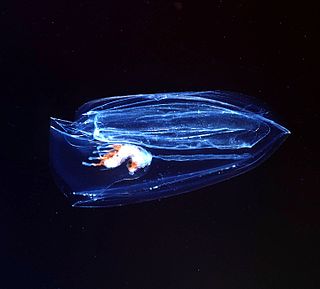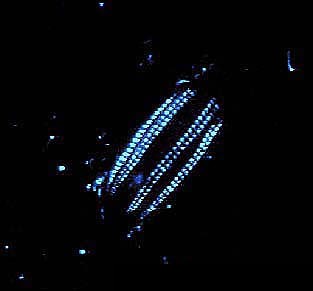
Cnidaria is a phylum under kingdom Animalia containing over 11,000 species of aquatic invertebrates found both in fresh water and marine environments, including jellyfish, hydroids, sea anemones, corals and some of the smallest marine parasites. Their distinguishing features are a decentralized nervous system distributed throughout a gelatinous body and the presence of cnidocytes or cnidoblasts, specialized cells with ejectable flagella used mainly for envenomation and capturing prey. Their bodies consist of mesoglea, a non-living, jelly-like substance, sandwiched between two layers of epithelium that are mostly one cell thick. Cnidarians are also some of the few animals that can reproduce both sexually and asexually.

Ctenophora comprise a phylum of marine invertebrates, commonly known as comb jellies, that inhabit sea waters worldwide. They are notable for the groups of cilia they use for swimming, and they are the largest animals to swim with the help of cilia.

Beroidae is a family of ctenophores or comb jellies more commonly referred to as the beroids. It is the only known family within the monotypic order Beroida and the class Nuda. They are distinguished from other comb jellies by the complete absence of tentacles, in both juvenile and adult stages. Species of the family Beroidae are found in all the world's oceans and seas and are free-swimmers that form part of the plankton.

Lobata is an order of transparent marine invertebrates belonging to the phylum of Ctenophora in the class Tentaculata, and are commonly referred to as comb jellies or sea gooseberries. There are currently 19 extant known species in the order of Lobata. Members of Lobata exhibit a compressed body in the vertical plane and a pair of oral lobes. They are known to inhabit marine pelagic surfaces and the marine shores.

Bathocyroe fosteri is a species of lobate ctenophore found at intermediate depths in all the world's oceans. The species is very common and abundant near the Mid-Atlantic Ridge. It is bioluminescent, and is typically observed hanging motionlessly in an upright or inverted posture although it can flap its oral lobes to swim. This deep-sea comb jelly is named for Alvin (DSV-2) pilot Dudley Foster, who collected the first specimens.

Lampocteis is a monotypic genus of comb jellies, the only genus in family Lampoctenidae. The sole species in this new genus is Lampocteis cruentiventer, the bloodybelly comb jelly. This ctenophore was first collected in the Pacific Ocean off the coast of San Diego, California, in 1979. It was described in 2001. The generic name was formed from the Ancient Greek lampós and kteís ("comb"), referring to the iridescence of its "combs"; the specific epithet was formed from the Latin cruentus ("blood-red") and venter ("belly"). Two morphological differences separating it from previously known comb jellies warranted the naming of a new family for this animal. These jellies are typically found at a depth of 250-1,500 meters deep in the North Pacific Ocean.

Ocyropsis, a genus within the comb jelly phylum Ctenophora, belonging to the family of Ocyropsidae, are characterized by their prominent muscular lobes and four auricles. These pale, translucent organisms inhabit a wide range of oceanic environments, from warm tropical waters to the cold depths. Unlike many other ctenophores, which are relatively slow-moving, Ocyropsis species are agile predators, utilizing their powerful lobes for rapid propulsion. Additionally, they possess the ability to secrete bioluminescent mucus, a defense mechanism that can disorient and deter potential threats. To capture prey, Ocyropsis employ their muscular lobes to seize and manipulate food items, subsequently transferring them to their prehensile mouths for ingestion.

Cydippida is an order of comb jellies. They are distinguished from other comb jellies by their spherical or oval bodies, and the fact their tentacles are branched, and can be retracted into pouches on either side of the pharynx. The order is not monophyletic, that is, more than one common ancestor is believed to exist.

Lyrocteis is a genus of benthic comb jellies. It is the only genus in the monotypic family Lyroctenidae.
Cryptolobatidae is a family of ctenophores. It is the only family in the monotypic order Cryptolobiferida and contains two genera, each with a single species.

The benthic comb jelly is a comb jelly living in the Ryukyu Trench near Japan. Found at a depth of 7,217 metres (23,700 ft), it is the deepest dwelling ctenophore discovered. Since its discovery, similar comb jellies have been found in the New Britain and Yap trenches.

Leucothea is a genus of ctenophores in the monotypic family Leucotheidae.
The Michael Sars Centre is a research institute at the University of Bergen located in Bergen, Norway. It consists of an international community of scientists that use advanced technologies to study the unique molecular and cellular biology of marine organisms.

Scleroctenophora is an extinct class of stem group ctenophores, known from the Chinese Maotianshan shales of Yunnan. It is dated to Cambrian Stage 3 and belongs to late Early Cambrian strata. Scleroctenophorans are easily distinguished from other ctenophores by the presence of an internal skeleton that supports the body.

Thalassocalyce is a genus of ctenophore, or comb jellies, known from the California Coast, Gulf of Mexico, and west north Atlantic. It is represented by a single species, Thalassocalyce inconstans, which is the only species in the family Thalassocalycidae and the order Thalassocalycida. T. inconstans is a pelagic ctenophore typically occurring in upper-mesopelagic depths, but has been observed at depths up to 3,500 m in Monterey Canyon.

Beroe abyssicola is a species of beroid ctenophore, or comb jelly. It is largely found in deep waters in the North Pacific Ocean, and is common in Japan and the Arctic Ocean. A predator, B. abyssicola feeds mostly on other ctenophores by swallowing them whole. Like other ctenophores, B. abyssicola has a simple nervous system in the form of a nerve net, which it uses to direct its movement, feeding, and hunting behaviors.

Aulacoctena is a monotypic genus of ctenophores belonging to the monotypic family Aulacoctenidae. The only species is Aulacoctena acuminata.

Euplokamis is a genus of ctenophores, or comb jellies, belonging to the monotypic family Euplokamididae. It shares the common name sea gooseberry with species of the genus Pleurobrachia. After being originally described by Chun (1879), the family Euplokamididae was expanded by Mills (1987) due to the discovery of a new species, Euplokamis dunlapae. Further research indicated that Euplokamis should be identified from Mertensiidae due to the rows of combs and some compression. They may also be distinguished from the genus Pleurobrachia due to their more elongated shape. Additionally, various adaptations of Euplokamis have been observed such as the use of tentacles for movement/feeding, a complex nervous system, and bioluminescent capabilities. Other characteristics including a defined mesoderm, lack of stinging cells, developmental differences, and symmetry supported the reclassification of these organisms.
Platyctenidae is a family of ctenophores belonging to the order Platyctenida.
Euplokamis dunlapae is a marine species of ctenophore. It is the first species of ctenophora reported to have giant axons controlling the comb rows. They control the ciliary beating, allowing for rapid change in the speed and direction of the cilia, likely evolved as an escape mechanism.














